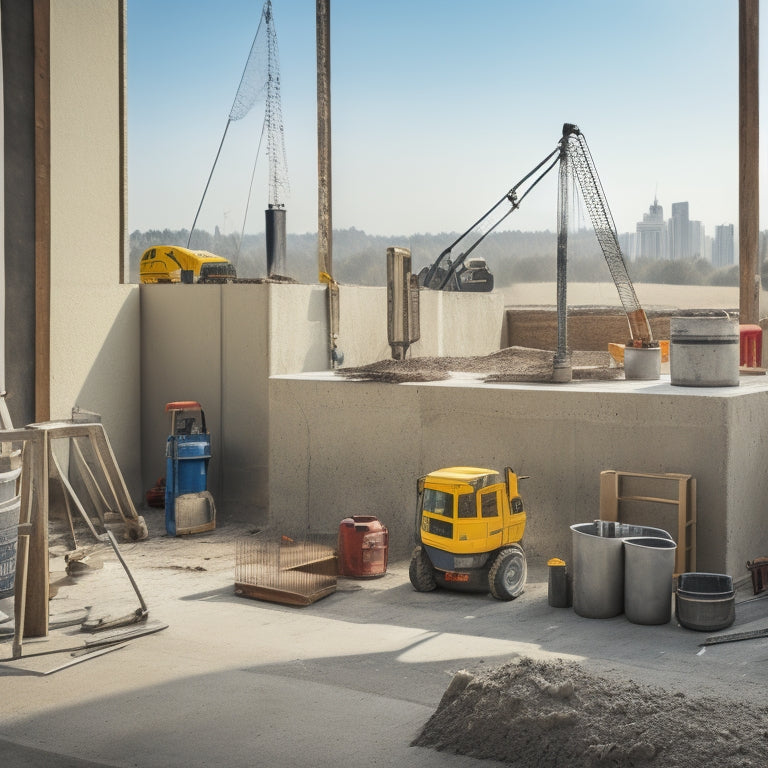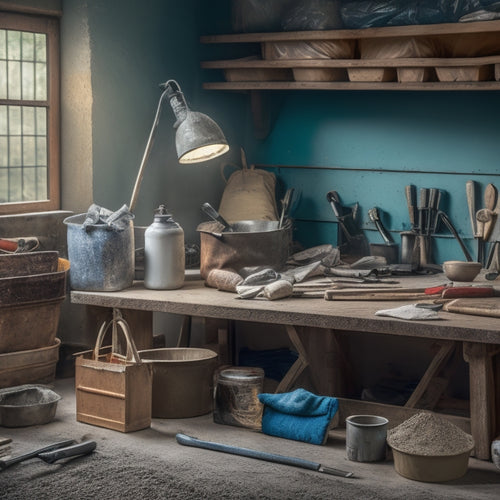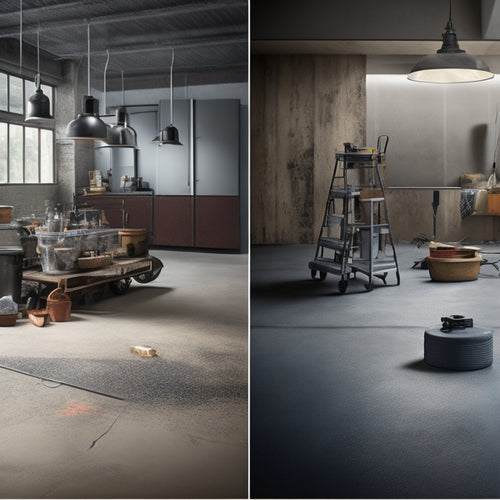
Top 7 Tools for Concrete Block Walls
Share
When building a concrete block wall, you'll need a range of specialized tools to guarantee a strong, durable, and professional-looking finish. You'll require a tamping tool for compaction, a block laying trowel for mortar application, and leveling and alignment tools like a laser level and spirit level to ensure accuracy. A mortar mixer and wheelbarrow will help you prepare and transport materials efficiently. A pointing trowel and jointer are necessary for filling and shaping joints, and safety gear like hard hats and gloves will protect you from hazards. With these top 7 tools, you'll be well-equipped to tackle your concrete block wall project - and mastering their uses will take your skills to the next level.
Key Takeaways
• Compaction tools like tamping tools are essential for ensuring structural integrity of concrete block walls by preventing settlement.
• Mortar application tools, including block laying trowels and pointing trowels, are necessary for applying and shaping mortar for strong bonds.
• Leveling and alignment tools, such as laser levels and spirit levels, guarantee accurate wall leveling and alignment for a professional finish.
• Mixing and transport tools, including mortar mixers and wheelbarrows, are vital for preparing and transporting mortar to the right consistency.
• Safety gear, including hard hats and safety glasses, protects workers from hazards and ensures successful project execution.
Tamping Tool for Compaction
When constructing a concrete block wall, you'll need a tamping tool to compact the soil and gravel base course to prevent settling and assure a stable foundation. This essential step guarantees the wall's structural integrity, and improper compaction can lead to costly repairs or even collapse. A tamping tool allows you to achieve peak compaction, which is especially critical in areas with high water tables or unstable soil conditions.
Mastering tamping techniques is fundamental to reap the compaction benefits. Start by dividing the base course into manageable sections, typically 2-3 square feet.
Hold the tamping tool vertically and strike the soil with a controlled, downward motion, applying consistent pressure. This helps to remove air pockets and densify the material.
Repeat the process until the soil is compacted to the desired level, usually indicated by a solid, unyielding surface.
Block Laying Trowel Essentials
Lay the groundwork for a successful concrete block wall by selecting a high-quality block laying trowel, an essential tool that helps you apply and hold the perfect amount of mortar.
As you choose from various block trowel types, consider the specific demands of your project. A V-notch trowel is ideal for applying large amounts of mortar, while a square-notch trowel is better suited for smaller applications.
You'll also need to master trowel handling techniques to guarantee efficient and effective mortar application. Hold the trowel at a 45-degree angle, using your wrist to control the flow of mortar. This allows you to maintain the perfect amount of pressure and achieve a smooth, even layer.
Practice your troweling technique to develop muscle memory and consistency. Remember, a good block laying trowel is only as effective as the person wielding it.
Leveling and Alignment Tools
With your mortar application skills honed, you're ready to focus on guaranteeing your concrete block wall is accurately leveled and aligned, which is where leveling and alignment tools come into play. These tools are essential for achieving a straight and even wall, and they'll save you time and frustration in the long run.
A laser level is an indispensable tool for leveling and aligning your wall. This device projects a precise level line, allowing you to check the alignment of your blocks and make adjustments as needed. You can also use it to establish a reference point for your wall, making sure it remains straight and true.
In addition to a laser level, alignment stakes are another critical tool for achieving accurate alignment. These stakes are driven into the ground at regular intervals, providing a visual reference point for your block placement.
By using alignment stakes in conjunction with a laser level, you can guarantee your wall is both level and plumb, resulting in a professional-looking finish.
Mortar Mixer and Wheelbarrow
When building concrete block walls, you'll need to mix mortar to the right consistency, transport it efficiently, and keep your tools in top shape.
As you work with your mortar mixer and wheelbarrow, you'll want to focus on getting the perfect mix, handling the wheelbarrow with ease, and maintaining your tools to guarantee longevity.
Mixing Mortar to Perfection
You'll need to accurately proportion and mix mortar to guarantee a strong, durable bond between your concrete blocks, and a mortar mixer and wheelbarrow are essential tools to achieve this. Proper mixing techniques are vital to confirm the mortar consistency is ideal for laying concrete blocks.
Here are three key considerations to get it right:
-
Start with the right ratio: A general mix ratio of 1 part cement to 2.5 parts sand is a good starting point, but this may vary depending on the specific requirements of your project.
-
Add water gradually: Mix the dry ingredients first, then add water slowly until you achieve the desired consistency. Aim for a workable mix that's not too runny or too stiff.
-
Mix thoroughly and patiently: Use your mortar mixer to blend the ingredients for at least 5 minutes, scraping the sides of the mixer regularly to confirm all ingredients are fully incorporated.
Efficient Wheelbarrow Handling
How efficiently can you handle a wheelbarrow, maneuvering it around the construction site while maintaining control of the mortar mixer, to guarantee a seamless workflow?
Mastering wheelbarrow techniques is vital for efficient transport of mortar to the block-laying area. To start, verify the wheelbarrow is properly loaded, with the mortar mixer situated at a comfortable height to prevent straining.
When pushing the wheelbarrow, keep your back straight, engage your core, and use your leg muscles to propel the load forward. This will help you maintain control and avoid spills.
As you navigate the site, use short, deliberate strides to maintain balance and stability. When turning, use your body weight to pivot the wheelbarrow, keeping the load centered.
By employing these techniques, you'll be able to efficiently transport mortar to the block-laying area, guaranteeing a smooth and continuous workflow.
With practice, you'll develop the skills and confidence to handle the wheelbarrow with ease, streamlining your construction process.
Proper Tool Maintenance
Regularly inspect and maintain your mortar mixer and wheelbarrow to affirm they remain in ideal working condition, thereby preventing equipment failures that can disrupt your workflow. A well-maintained tool affirms efficiency, accuracy, and safety on the job site.
To keep your mortar mixer and wheelbarrow in top shape, follow these essential maintenance tips:
-
Cleanliness is key: Develop a routine of tool cleaning techniques, such as scrubbing the mixer's drum and blades, and washing the wheelbarrow's tub and tires. This prevents material buildup and corrosion.
-
Schedule regular checks: Create a maintenance schedule to inspect your tools regularly, looking for signs of wear, damage, or malfunction. This allows you to address issues promptly and prevent minor problems from becoming major ones.
-
Lubricate and protect: Apply lubricants to moving parts, and protect your tools from the elements by storing them in a dry, covered area.
Spirit Level and Straightedge
When building a concrete block wall, you'll need to guarantee accurate angle measurements, level surface verification, and straight line creation to achieve a sturdy structure.
Your spirit level and straightedge will become essential tools in this process, helping you to detect even the slightest deviations from perfect horizontal and vertical planes.
Accurate Angle Measurement
You'll need to guarantee accurate angle measurement for your concrete block wall project, and a spirit level and straightedge are the essential tools to get it right. These tools enable you to achieve precision layout, verifying your wall is straight, level, and plumb. Inaccurate angle measurements can lead to a host of problems, including structural issues and aesthetic flaws.
To verify accurate angle measurement, follow these steps:
-
Use a spirit level to establish a reference line: This provides a baseline for your measurements, verifying your wall is perfectly vertical or horizontal.
-
Employ angle measurement techniques: Use your straightedge to create precise angles, whether it's a 90-degree corner or a more complex angle.
-
Verify your measurements: Double-check your work to verify accuracy, making adjustments as needed to guarantee a precise layout.
Level Surface Verification
To guarantee a level surface, hold your spirit level against the concrete block wall, using the straightedge to extend the level's surface, and then check the bubble's position within the vial to verify a perfectly horizontal or vertical surface. This step is vital in surface preparation techniques, as an uneven surface can lead to a weak structure.
By confirming the surface is level, you'll prevent issues like water seepage, cracks, and structural damage.
When verifying the level surface, pay attention to the bubble's position. If it's centered, your surface is level. If it's not, adjust the surface accordingly. Repeat this process at multiple points along the wall to confirm consistency.
A level surface is essential for a strong and durable concrete block wall. In leveling techniques, this step is often overlooked, but it's vital for a successful project. By taking the time to verify the level surface, you'll save time and resources in the long run.
Straight Line Creation
Using your spirit level and straightedge, create a straight line along the concrete block wall by aligning the level's vial with the desired angle, then tracing the line with a pencil or marker. This guarantees accuracy and precision in your line marking.
To achieve a perfectly straight line, follow these steps:
-
Secure the straightedge: Place the straightedge along the wall, holding it firmly in position with one hand.
-
Align the spirit level: Place the spirit level on top of the straightedge, making sure the vial is centered and the bubble is between the lines.
-
Mark the line: With the level and straightedge aligned, carefully draw a line along the wall using a pencil or marker.
As you create the line, consider using a guide string to help maintain the straightedge's position. This is especially useful for longer lines or when working alone.
Pointing Trowel and Jointer
A pointing trowel and jointer are essential tools for finishing and repairing concrete block walls, as they enable you to fill gaps and smooth out joints with precision.
With these tools, you can achieve professional-looking results by mastering various pointing techniques. The pointing trowel is used to fill and shape the joints, while the jointer helps to compress and finish the joint.
To get the best joint finishes, you'll want to use the pointing trowel to fill the joint to the correct depth, then use the jointer to compress the material and create a smooth, even surface.
This process requires patience and practice, but with the right tools and techniques, you'll be able to achieve consistent, high-quality results. Remember to always clean and prepare the joint before filling, and use the correct type of filling material for the job.
Safety Gear and Protective Wear
You'll need to gear up with the right safety equipment and protective wear to prevent injuries and guarantee a successful concrete block wall project. As you work with heavy blocks, mortar, and power tools, it's essential to prioritize your safety above all else.
Here are the essential safety gear and protective wear you should invest in:
-
Hard hat and safety glasses: Protect your head and eyes from falling debris, dust, and other hazards.
-
Steel-toed boots and gloves: Prevent foot and hand injuries from heavy blocks, tools, and materials.
-
Dust mask and respirator: Safeguard yourself from inhaling dust, silica, and other airborne particles that can cause respiratory issues.
Frequently Asked Questions
Can I Use a Regular Shovel Instead of a Square-Edged Shovel?
When tackling a concrete block wall project, you're likely wondering if a regular shovel will suffice instead of a square-edged shovel.
While it's tempting to use what you have, a regular shovel can hinder digging efficiency.
Square-edged shovels are specifically designed for cutting through dense materials like soil and concrete, allowing for more precise and efficient digging.
Invest in the right tool to guarantee your project's success.
How Often Should I Clean and Maintain My Tools?
You should prioritize regular tool cleaning and maintenance to guarantee tool longevity.
Establish a maintenance schedule, cleaning your tools after each use and performing thorough inspections weekly. This will prevent damage from debris buildup and corrosion.
Set aside time each month for more extensive maintenance, such as sharpening and lubricating moving parts.
Are There Any Specific Storage Requirements for Concrete Block Walls?
When storing concrete block walls, you'll want to prioritize moisture control to prevent water damage and structural issues.
Make certain the storage area is well-ventilated and dry, with a relative humidity below 60%.
Consider insulation options like waterproof coatings or breathable membranes to further protect the blocks.
Additionally, store blocks off the ground and away from direct sunlight to maintain their integrity.
Can I Use a Drill to Mix Mortar Instead of a Mixer?
You're tempted to channel your inner MacGyver, using a drill to mix mortar instead of a dedicated mixer. While it's doable, it's not the most efficient approach.
With a drill, you'll struggle to achieve the ideal mortar consistency, and the risk of uneven mixing increases.
Opt for a hammer drill or a rotary hammer drill specifically designed for mixing mortar, ensuring a smooth, consistent blend.
Anything less, and your concrete block walls might end up as wobbly as a house of cards.
Are There Any Local Building Codes I Need to Follow?
Before starting your concrete block wall project, you'll need to familiarize yourself with local regulations.
Check with your city or county government to determine if you need building permits or special licenses.
You must comply with local building codes, which may vary depending on your location.
Research and understand the specific requirements to avoid costly mistakes or project delays.
Conclusion
You've built a fortress, brick by brick, with precision and care.
As you step back to admire your concrete block wall, remember that each tool played a crucial role in its construction.
Like a master conductor, you orchestrated the harmony of tamping, laying, leveling, mixing, and pointing, with safety as your constant refrain.
Your wall stands strong, a tribute to your skill and attention to detail, a symphony of concrete and craftsmanship.
Related Posts
-

Must-Have Tools for Laying Concrete Tiles
When laying concrete tiles, you'll need a range of essential tools to get the job done right. Start with subfloor pre...
-

10 Must-Have Tools for Small Concrete Projects
When tackling small concrete projects, you'll need a range of essential tools to achieve professional-grade results. ...
-

Top Tools for Revamping Old Concrete Floors
You'll need a range of tools to revamp your old concrete floor, starting with epoxy, acrylic, or polyurethane paint, ...


